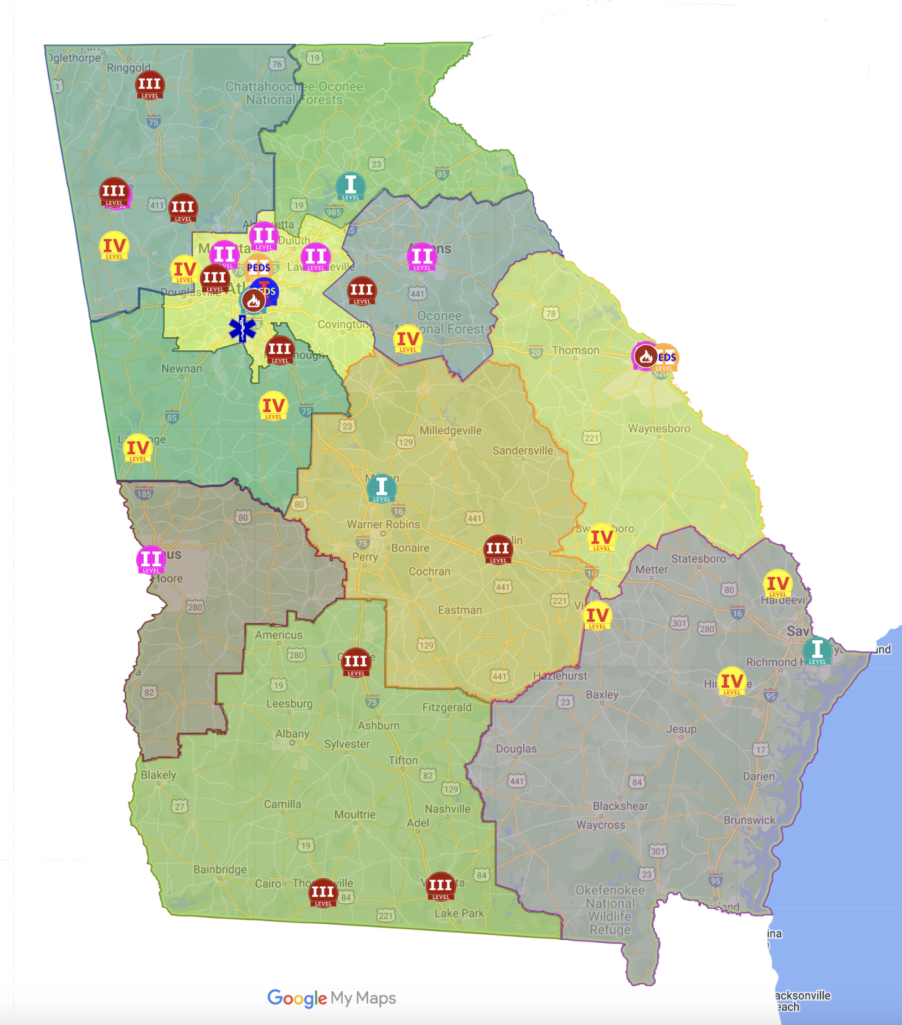
Stories about struggling rural hospitals are nothing new. Low revenue and high employee turnover have been hallmarks of the industry for years. In Northeast Georgia, Hart County shuttered its hospital. Habersham Medical Center kept its doors open by handing Northeast Georgia Health System the keys.
What is new is finding a story about a rural hospital that has had the sort of turnaround Stephens County Hospital (SCH) is experiencing.
Just three short years ago, this 96-bed acute care hospital located in Toccoa posted an annual loss of $7.6 million. This year, it’s expected to turn a modest profit.
How did they do it? It started with promoting Van Loskoski.
Tough decisions and teamwork
Loskoski is a Georgia Tech graduate who spent six years as a healthcare analyst in Savannah before moving to Toccoa. In 2019, Stephens County Hospital hired him as vice president of physician practices. After two years in that job, he was named chief operating officer, and four months later, the hospital authority promoted Loskoski to CEO.
His promotion in September 2021 came at the end of another dismal fiscal year for the hospital. Staring at millions in debt and the same tough decisions Hart and Habersham counties had to make, Loskoski set out on a mission to improve the hospital’s financial position. First, though, he knew he had to improve employee recruitment and retention and burnish the hospital’s reputation. Neither task would be easy. After years of cutbacks, Stephens County Hospital was understaffed and ranked at the bottom of hospital customer satisfaction surveys.
Loskoski put together a team to improve the hospital’s image. In less than three years, the team of administrators, staff, and partnerships he assembled has turned the struggling rural hospital into an “up-and-comer” in the health care industry.
From in the red to in the black

In an interview with Now Habersham, Loskoski said that after years of operating in the red, he and his team set a goal to keep operating margins as close to break even as possible.
It’s paying off.
Although the hospital is on track to lose $212,000 this year, other revenue sources will offset that loss. Now, halfway through the current fiscal year, it appears Stephens County Hospital will close the year with a $29,000 profit.
The financial turnaround is due, in part, to the leadership team’s new mindset. Loskoski says they are focused on delivering what the community needs and being transparent. They are also focused on what the region needs, asking themselves, “Why are members of the community leaving the area to find health care elsewhere?”
Asking that question and heeding the answer resulted in a $19 million increase in gross revenue last year. Here’s how.
Hospital officials determined that general surgery was the number one service people were getting elsewhere. They found that surgical patients were either going to Gainesville or Athens for treatment. The team also determined that the reason for this “out-migration” was retirement: Many of their hospital’s surgeons had retired, and the hospital was too poorly staffed to maintain those services when they left.
Once they identified the problem and its contributing factors, Loskoski and his team set about rebuilding. They sought out doctors to live in and become part of the community. Dr. Cecil Brown was hired to lead the hospital’s general surgical team. He came to Toccoa from Gainesville, where he spent seven years working in the trauma program at Northeast Georgia Health System. Brown is originally from Sandersville, Georgia, and understands small communities’ needs.
The hospital now has five surgeons in its surgical rotation.
Stephens County Hospital has also expanded its orthopedic services, not just in Toccoa but also in Hartwell. It is now an accredited center of excellence in knee and hip replacement surgeries.
By addressing out-migration and the factors feeding into it, Stephens County Hospital was able to strategically address the problem and spur a financial turnaround. The hospital’s surgery volume has tripled in two years, resulting in significant revenue growth.
Building partnerships
Outside partnerships have also played an essential role in the hospital’s turnaround.
On February 1, the hospital began partnering with a hospital internist group to manage its med/surg department and intensive care unit. The goal is to increase care locally rather than sending patients to another facility for those services.

While studying community needs, Loskoski states his team discovered that cardiovascular disease was the number one cause of mortality in Stephens County. At the time, Stephens County Hospital didn’t offer cardiovascular care, and local physicians were referring patients to disease treatment facilities outside the county.
To address this challenge, Loskoski and the team leaned into a partnership with Northside Hospital. They spent a year setting up a program to bring cardiovascular physicians to Stephens County. Now, when a patient sees a cardiologist at Stephens County Hospital, that physician is actually an employee of Northside Hospital.
Another hospital partnership just celebrated its one-year anniversary in February. Wellstar Health System teamed up with Stephens County to provide stroke care. That was another community need that Loskoski says was not being properly met.
The stroke program took about a year to implement. Now, Stephens County Hospital has seven vascular neurologists on staff. They are Wellstar employees who work in Stephens County.
Some physicians work remotely, and advances in telemedicine have made that possible.
Other technological advances have radically improved the quality of stroke care at Stephens County Hospital. High-tech imaging devices can detect a stroke immediately and notify ER doctors, internists, and vascular neurologists. This eliminates the need to wait for a radiologist to read the scan, allowing treatment to begin almost immediately.
This reduces the severity of strokes, allowing two-thirds of the patients to remain at Stephens County Hospital for their stroke care rather than having to be rushed to another facility for treatment.
Overcoming stigmas

Fair or not, rural hospitals can develop a stigma for being poor health care providers. Many factors contribute to this. A lack of funding can prevent hospitals from hiring the physicians and nurses they need to be fully staffed. Also, smaller hospitals generally lack the necessary resources to implement medical advances as quickly as larger hospitals. These problems compound themselves when word-of-mouth and patient satisfaction surveys negatively impact a hospital’s image.
When Loskoski took over as CEO, he says Stephens County Hospital had been at the bottom of the heap in patient satisfaction surveys for at least two years.
“Literally, every single hospital in the state of Georgia had better patient satisfaction scores than we did,” he says.
Instead of shying away from the criticism, hospital leaders used it to spur them on to do better.
“We had to have some really hard conversations with ourselves,” the CEO says.
The change did not come by putting new people at the top but rather by adopting a customer service mentality.
As Loskoski explains, customer service in health care is about more than merely prescribing the right treatments and medication; it is about being proactive and explaining to patients why they need those interventions. Customer service is also about the staff and patients knowing who they are talking to and treating patients as people, not just numbers. Patients are encouraged to ask questions and voice their concerns.
Since implementing these changes and shifting its mindset, Stephens County Hospital is no longer at the bottom of the heap. In just two years, it has gone from being last in the state to having a 97% patient satisfaction rating.
In December, Georgia Trend magazine had Stephens County Hospital tied for second with two other hospitals in the Top Small Hospital category.
Workforce culture
Simultaneously with all the other changes happening, hospital leaders set out to improve the work environment. Years of cutbacks and cost-cutting had established a culture at Stephens County Hospital in which the workforce seemed to be a burden to the administration. Loskoski brought with him a fresh perspective.
“You can not cut your way to profitability. You can not cut your way to success,” he says.
The hospital began reinvesting in its staff. Three years ago, 25 travel nurses helped cover a staffing shortage. Today, there are none. The hospital has hired its own nurses to provide consistent care.
The hospital achieved this by paying its staff a competitive wage and reinvesting in employees’ retirement plans. This allows the hospital to recruit and retain staff, especially nurses.
In 2021, Stephens County Hospital had a 52% nursing turnover rate. Today, that number has dropped to 11%.
Hospital workers are not the only ones benefiting from the change.
“Your patients feel it,” says Loskoski. “You (the patient) are treated better by a staff member that is treated well when they come to work.”
Trauma Center goal
With so much achieved in such a short amount of time, it’s hard to imagine what could be next. Then Loskoski mentions opening a new regional trauma center.

There are two trauma centers in Northeast Georgia – a Level I center in Gainesville and a Level II in Athens. For most people in the region, either is at least 30 miles away and if a medical chopper is not available, an ambulance ride could mean the difference between life and death.
“We felt our community needed better support than that,” says Loskoski.
With its new surgical team and medical partnerships in place, Stephens County Hospital is poised to possibly become the region’s third trauma center. The hope is to obtain that designation by 2025. If past performance is any indication, this Stephens County Hospital team of administrators and staff can make that happen.







